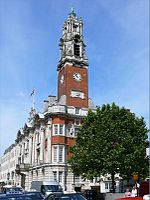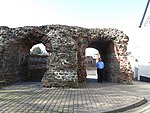Albert Hall, Colchester
Buildings and structures in Colchester (town)Commercial buildings completed in 1845Corn exchanges in EnglandGrade II listed buildings in EssexUse British English from May 2023

The Albert Hall is a commercial building in the High Street, Colchester, Essex, England. The structure, which was commissioned as a corn exchange and is now used as a bank, is a Grade II listed building.
Excerpt from the Wikipedia article Albert Hall, Colchester (License: CC BY-SA 3.0, Authors, Images).Albert Hall, Colchester
High Street, Colchester
Geographical coordinates (GPS) Address Nearby Places Show on map
Geographical coordinates (GPS)
| Latitude | Longitude |
|---|---|
| N 51.8898 ° | E 0.8971 ° |
Address
The Co-operative Bank
High Street
CO1 1JW Colchester
England, United Kingdom
Open on Google Maps










